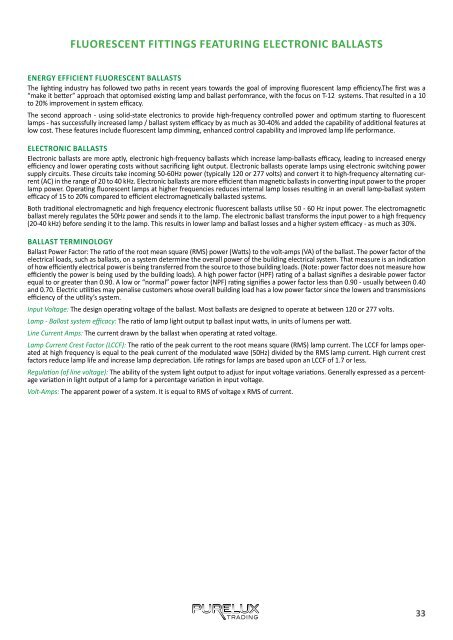Purelux Catalog 2018
Purelux Product Catalog.
Purelux Product Catalog.
You also want an ePaper? Increase the reach of your titles
YUMPU automatically turns print PDFs into web optimized ePapers that Google loves.
fluorescent fittings featuring electronic ballasts<br />
energy efficient fluorescent ballasts<br />
The lighting industry has followed two paths in recent years towards the goal of improving fluorescent lamp efficiency.The first was a<br />
“make it better” approach that optomised existing lamp and ballast perfomrance, with the focus on T-12 systems. That resulted in a 10<br />
to 20% improvement in system efficacy.<br />
The second approach - using solid-state electronics to provide high-frequency controlled power and optimum starting to fluorescent<br />
lamps - has successfully increased lamp / ballast system efficacy by as much as 30-40% and added the capability of additional features at<br />
low cost. These features include fluorescent lamp dimming, enhanced control capability and improved lamp life performance.<br />
electronic ballasts<br />
Electronic ballasts are more aptly, electronic high-frequency ballasts which increase lamp-ballasts efficacy, leading to increased energy<br />
efficiency and lower operating costs without sacrificing light output. Electronic ballasts operate lamps using electronic switching power<br />
supply circuits. These circuits take incoming 50-60Hz power (typically 120 or 277 volts) and convert it to high-frequency alternating current<br />
(AC) in the range of 20 to 40 kHz. Electronic ballasts are more efficient than magnetic ballasts in converting input power to the proper<br />
lamp power. Operating fluorescent lamps at higher frequencies reduces internal lamp losses resulting in an overall lamp-ballast system<br />
efficacy of 15 to 20% compared to efficient electromagnetically ballasted systems.<br />
Both traditional electromagnetic and high frequency electronic fluorescent ballasts utilise 50 - 60 Hz input power. The electromagnetic<br />
ballast merely regulates the 50Hz power and sends it to the lamp. The electronic ballast transforms the input power to a high frequency<br />
(20-40 kHz) before sending it to the lamp. This results in lower lamp and ballast losses and a higher system efficacy - as much as 30%.<br />
ballast terminology<br />
Ballast Power Factor: The ratio of the root mean square (RMS) power (Watts) to the volt-amps (VA) of the ballast. The power factor of the<br />
electrical loads, such as ballasts, on a system determine the overall power of the building electrical system. That measure is an indication<br />
of how efficiently electrical power is being transferred from the source to those building loads. (Note: power factor does not measure how<br />
efficiently the power is being used by the building loads). A high power factor (HPF) rating of a ballast signifies a desirable power factor<br />
equal to or greater than 0.90. A low or “normal” power factor (NPF) rating signifies a power factor less than 0.90 - usually between 0.40<br />
and 0.70. Electric utilities may penalise customers whose overall building load has a low power factor since the lowers and transmissions<br />
efficiency of the utility’s system.<br />
Input Voltage: The design operating voltage of the ballast. Most ballasts are designed to operate at between 120 or 277 volts.<br />
Lamp - Ballast system efficacy: The ratio of lamp light output tp ballast input watts, in units of lumens per watt.<br />
Line Current Amps: The current drawn by the ballast when operating at rated voltage.<br />
Lamp Current Crest Factor (LCCF): The ratio of the peak current to the root means square (RMS) lamp current. The LCCF for lamps operated<br />
at high frequency is equal to the peak current of the modulated wave (50Hz) divided by the RMS lamp current. High current crest<br />
factors reduce lamp life and increase lamp depreciation. Life ratings for lamps are based upon an LCCF of 1.7 or less.<br />
Regulation (of line voltage): The ability of the system light output to adjust for input voltage variations. Generally expressed as a percentage<br />
variation in light output of a lamp for a percentage variation in input voltage.<br />
Volt-Amps: The apparent power of a system. It is equal to RMS of voltage x RMS of current.<br />
trading<br />
33




